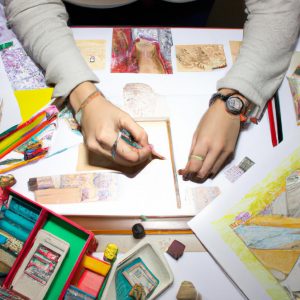Graphic Novel Publishing: A Guide to Creative Loans in the Arts and Comics

The world of graphic novel publishing has undergone significant transformations in recent years, with the rise in popularity and recognition of this unique art form. As more artists and writers venture into creating their own comics, the financial aspect of bringing these works to life becomes a crucial consideration. Creative loans have emerged as a viable option for aspiring comic creators to obtain funding for their projects, allowing them to navigate the complex landscape of the arts industry. To illustrate the importance and effectiveness of creative loans, let us consider the case study of Jane, an up-and-coming illustrator who dreams of self-publishing her first graphic novel.
Jane’s journey began with a simple idea: a captivating story that transcends traditional narrative boundaries through striking visuals and engaging dialogue. However, she soon realized that turning her vision into reality would require not only immense creativity but also substantial financial resources. Faced with limited personal funds and skeptical investors hesitant to support unproven talent, Jane turned to creative loans as her means of accessing the necessary capital. By securing financing from a specialized lending institution that understands the nuances of artistic ventures, Jane was able to bring her graphic novel project to fruition while retaining full creative control over its content and direction. This exemplifies how creative loans can empower talented individuals like Jane by providing them with the financial backing they need to bring their artistic visions to life, without compromising their creative integrity.
Creative loans offer several advantages for artists and writers looking to self-publish their work. Firstly, unlike traditional loans that may require collateral or a proven track record of success, creative loans are often based on the potential of the project itself. Lending institutions specializing in creative financing understand the unique challenges faced by individuals in the arts industry and are more willing to take risks on innovative projects.
Additionally, creative loans can provide flexible repayment terms tailored to the artist’s specific needs. This flexibility allows creators like Jane to focus on their art rather than worrying about strict repayment schedules. It also recognizes that returns on artistic endeavors may not be immediate and provides leeway for income generation from book sales or other revenue streams.
Furthermore, creative loans can serve as a stepping stone towards building credibility within the industry. By successfully completing her graphic novel with the help of a loan, Jane establishes herself as a serious creator capable of delivering high-quality work. This can lead to increased opportunities for future projects, including potential collaborations with publishers or attracting attention from investors who may have been initially hesitant.
In conclusion, creative loans play a vital role in supporting aspiring comic creators like Jane who wish to self-publish their graphic novels. These loans provide necessary funding while allowing artists to maintain control over their vision and direction. With access to financial resources through creative loans, talented individuals can bring their stories and artwork into the world, contributing to the ever-evolving landscape of graphic novel publishing.
Understanding Graphic Novel Publishing
Graphic novel publishing is a multifaceted industry that combines the art of storytelling with visual imagery. To comprehend this unique form of publication, it is essential to explore its various components and understand the intricacies involved in bringing graphic novels to life.
One example that exemplifies the complexity of graphic novel publishing is the critically acclaimed series “Watchmen” by Alan Moore and Dave Gibbons. This groundbreaking work revolutionized the genre by incorporating complex narratives, thought-provoking themes, and visually stunning artwork. By analyzing the success of “Watchmen,” we can gain insight into the key elements that contribute to a successful graphic novel.
To fully grasp the dynamics of graphic novel publishing, it is important to address some crucial aspects:
- Collaborative Process: Creating a graphic novel often involves collaboration between writers, artists, colorists, letterers, and editors. Each contributor plays an integral role in shaping the final product.
- Visual Storytelling: Unlike traditional novels, graphic novels rely heavily on visual storytelling techniques. The combination of illustrations and text allows for a more immersive reading experience.
- Narrative Structure: A well-crafted narrative structure is vital in engaging readers throughout a graphic novel. Elements such as pacing, panel layouts, and page composition all contribute to how effectively the story unfolds.
- Artistic Style: The artistic style employed in a graphic novel greatly influences its overall tone and aesthetic appeal. From realistic portrayals to stylized interpretations, each approach carries its own impact on reader engagement.
Embracing these core concepts within graphic novel publishing lays a solid foundation for understanding this captivating medium. By recognizing the collaborative nature of creating visually-driven narratives with compelling storytelling structures and distinct artistic styles, one can appreciate both the creative process behind these works and their significance in popular culture.
Transitioning into exploring the importance of financing in the arts helps shed light on another critical aspect of graphic novel publishing – securing financial support to bring these creative endeavors to fruition.
Exploring the Importance of Financing in the Arts
From understanding the intricacies of graphic novel publishing to exploring its financial aspects, it is evident that financing plays a vital role in bringing these artistic works to life. To further emphasize this point, let us consider the case study of an aspiring comic book artist named Alex.
Alex has been working tirelessly on creating their own graphic novel series. They have spent years honing their craft and developing unique characters and storylines. However, like many artists, they face the challenge of securing funds to turn their creative vision into a tangible reality. This is where loans become indispensable in the world of graphic novel publishing.
When it comes to financing art projects such as graphic novels, there are several important considerations for both artists and lenders:
- Risk vs Reward: Lenders evaluate the potential success of a graphic novel project before providing financial assistance. Established artists with proven track records may have an easier time obtaining loans due to reduced risk compared to emerging talents.
- Market Analysis: Assessing market demand and trends within the comics industry is crucial. Understanding target audiences, competitive landscapes, and sales projections can help determine if a loan investment will be financially viable.
- Budget Planning: Developing a comprehensive budget that covers various expenses involved in producing a graphic novel is essential when seeking funding. Costs may include artwork creation, printing, marketing campaigns, distribution channels, and more.
- Return on Investment: Lenders typically expect repayment along with interest or royalties once the published graphic novel starts generating revenue. Artists should carefully analyze projected earnings to ensure they can meet loan obligations while also sustaining their artistic careers.
The table below illustrates some key factors considered by lenders when evaluating loan applications for graphic novel publishing:
| Factors | Description |
|---|---|
| Artist’s Portfolio | Demonstrates skills, creativity, and past achievements in comic artistry |
| Story Concept | Unique and compelling narrative that appeals to target readership |
| Marketing Plan | Well-thought-out strategies to promote and distribute the graphic novel |
| Financial Projections | Realistic estimates of potential sales, revenue, and return on investment |
By understanding these considerations, artists like Alex can better navigate the world of financing in graphic novel publishing. In the following section, we will delve deeper into the role that loans play in this industry and explore how they can provide a crucial lifeline for artists seeking to bring their creative visions to fruition.
Transitioning seamlessly into our next topic, let us now examine “The Role of Loans in Graphic Novel Publishing” and shed light on how these financial instruments enable artistic endeavors to flourish.
The Role of Loans in Graphic Novel Publishing
As discussed earlier, financing plays a crucial role in the arts industry, including graphic novel publishing. Let us now delve deeper into how loans specifically contribute to the success and growth of graphic novels.
To illustrate this point, consider an aspiring comic artist named Alex who dreams of bringing their unique story to life through a graphic novel. However, like many artists, Alex faces financial constraints that limit their ability to self-publish or hire professionals for assistance. In this scenario, obtaining a loan can provide Alex with the necessary funds to cover expenses such as hiring illustrators, writers, editors, and designers, as well as printing and distribution costs – ultimately transforming their vision into reality.
Loans offer several advantages that make them essential tools for graphic novel publishers:
- Financial Flexibility: Loans enable artists to access immediate funding without depleting personal savings or relying solely on external investors.
- Creative Control: By securing a loan instead of seeking investment from outside sources, artists retain full creative control over their work.
- Market Entry: Loans facilitate market entry by providing resources for production and promotion activities critical in building awareness and attracting readership.
- Revenue Potential: Graphic novels have significant revenue potential through book sales, merchandise licensing deals, adaptations into other media formats (such as film or television), conventions appearances, and more.
| Scenario | Without Loan | With Loan |
|---|---|---|
| Resources | Limited budget for production and marketing | Sufficient funds for high-quality production |
| Team | Minimal professional support due to budget restraints | Ability to hire skilled individuals |
| Reach | Limited audience exposure | Wider reach through effective marketing strategies |
| Growth | Slower growth and potential limitations | Increased potential for success and expansion |
As demonstrated in this hypothetical comparison, securing a loan can significantly enhance the prospects of graphic novel publishing, providing artists with the means to produce high-quality work, reach a broader audience, and foster growth within the industry.
With a solid understanding of how loans contribute to graphic novel publishing, we can now turn our attention to navigating the creative funding landscape. This entails exploring alternative financing options beyond traditional loans that may better align with an artist’s unique circumstances and goals.
Navigating the Creative Funding Landscape
In the world of graphic novel publishing, loans play a crucial role in providing creators and publishers with the necessary financial support to bring their artistic visions to life. One example that demonstrates the significance of loans is the case of a budding comic artist who dreams of self-publishing their first graphic novel but lacks the funds to cover production costs. By obtaining a loan specifically tailored for creative ventures, this artist can secure the capital needed to hire illustrators, editors, and printers, resulting in a polished final product ready for distribution.
Loans serve as a catalyst for creativity by offering several advantages within the realm of graphic novel publishing:
- Flexibility: Unlike traditional grants or venture capital investments which often come with stipulations on how funds are allocated, loans provide borrowers with greater freedom and discretion over resource allocation.
- Expedited Production: The availability of quick financing ensures that publication timelines remain on track without compromising quality due to budget constraints or delays caused by waiting for alternative funding sources.
- Increased Autonomy: Borrowers retain control over their intellectual property rights when opting for loans rather than seeking external investors who may demand shares or influence over creative decisions.
- Long-Term Sustainability: Loans enable artists and publishers to establish sustainable revenue streams by facilitating investment in marketing efforts and expanding distribution networks.
To better understand the role of loans in graphic novel publishing, consider the following table showcasing different types of loans commonly utilized within the industry:
| Loan Type | Characteristics | Suitable For |
|---|---|---|
| Creative Venture | Tailored towards artists/publishers; flexible repayment terms | Self-published projects |
| Small Business | Designed for small-scale enterprises; offers competitive rates | Independent publishers |
| Crowdfunding | Utilizes online platforms; relies on community support | Collaborative projects |
| Non-profit Grants | Grants offered by organizations supporting graphic novel arts | Socially conscious works |
In summary, loans play a pivotal role in the world of graphic novel publishing, offering creators and publishers the financial means to transform their ideas into tangible realities. The flexibility, expedited production timelines, increased autonomy, and long-term sustainability provided by loans make them an essential tool for those seeking to navigate the dynamic landscape of creative financing.
Moving forward, the subsequent section will delve into valuable tips for securing financial support within the realm of comics, providing practical advice on how artists and publishers can access funding opportunities that align with their goals and aspirations.
Tips for Securing Financial Support in Comics
Transitioning from the previous section’s exploration of navigating the creative funding landscape, let us now delve into some practical tips for securing financial support in comics. To illustrate these strategies, consider a hypothetical scenario where an aspiring graphic novelist named Alex is seeking funding to publish their debut work.
-
Building a Strong Network:
One effective approach that can greatly increase your chances of securing financial support is by building a strong network within the comic industry and related artistic communities. By attending conventions, workshops, and networking events, you can connect with potential investors or sponsors who share your passion for graphic novels. Additionally, engaging with fellow artists and creators provides opportunities for collaboration or knowledge-sharing, potentially leading to new avenues of financing. -
Crafting Compelling Proposals:
Presenting a well-crafted proposal is crucial when approaching potential funders or organizations supporting arts-related projects. Your proposal should clearly articulate your vision for the graphic novel project while emphasizing its unique selling points. Including samples of artwork or excerpts from the story can help capture the interest of prospective supporters. Focus on highlighting how your work aligns with their values or objectives to enhance the likelihood of obtaining financial backing. -
Researching Grants and Funding Programs:
Conduct thorough research on grants and funding programs specifically tailored to support art initiatives, including those dedicated to promoting diversity and underrepresented voices in literature and visual arts. Many organizations offer grants exclusively for comic book creators or emerging artists working in similar mediums. Make sure to carefully review eligibility criteria and application deadlines before submitting proposals. -
Utilizing Crowdfunding Platforms:
Crowdfunding platforms have become increasingly popular among independent creators seeking financial backing for their projects. Websites such as Kickstarter, Indiegogo, and Patreon provide access to a large community of enthusiasts willing to contribute funds towards bringing innovative ideas to life. Effectively utilizing these platforms requires developing compelling campaign content that resonates with potential backers’ interests.
Emotional Impact
-
Bullet Point List:
- Inspire and engage with unique storytelling.
- Contribute to the expansion of diverse voices in the comic industry.
- Support emerging artists and their creative endeavors.
- Enable the creation of imaginative worlds that captivate readers.
-
Table:
| Funding Options | Pros | Cons |
|---|---|---|
| Grants | No repayment required | Highly competitive |
| Sponsorships | Financial support + exposure | Limited availability |
| Crowdfunding | Engage community | Time-consuming campaign setup |
As a graphic novelist, securing financial support is an essential step towards turning your artistic vision into reality. By building networks, crafting compelling proposals, researching available grants or funding programs, and utilizing crowdfunding platforms effectively, you can increase your chances of obtaining the necessary resources for publishing success.
Transitioning seamlessly into the subsequent section on maximizing opportunities for graphic novel success, we will now explore additional strategies to enhance your journey as a comics creator.
Maximizing Opportunities for Graphic Novel Success
Building on the tips discussed in securing financial support, it is crucial to explore strategies that can maximize opportunities for graphic novel success. By employing effective marketing techniques and leveraging various platforms, creators can enhance their chances of reaching a wider audience and achieving commercial triumph.
Case Study Example:
To illustrate this point, let us consider the case of an independent comic artist, Alex, who recently self-published his first graphic novel. While he had managed to secure some initial funding through crowdfunding campaigns and personal savings, Alex was now faced with the challenge of promoting his work and establishing a strong presence within the competitive industry.
Effective Strategies for Maximizing Graphic Novel Success:
-
Engage in targeted social media marketing:
- Craft compelling posts highlighting unique aspects of your graphic novel.
- Collaborate with influencers or relevant communities to gain exposure.
- Utilize hashtags related to comics, art, and literature to expand reach.
- Host contests or giveaways to generate buzz and attract potential readers.
-
Leverage e-commerce platforms:
- Create an appealing website or online store dedicated to selling your graphic novel.
- Optimize search engine results by using relevant keywords in descriptions.
- Offer exclusive digital content or limited edition merchandise as incentives for purchase.
- Seek partnerships with established online retailers catering to niche audiences.
-
Attend conventions and book fairs:
- Participate in events specific to comics and graphic novels.
- Showcase artwork at booths or tables to capture attention.
- Network with fellow artists, publishers, agents, and enthusiasts.
- Consider organizing panel discussions or workshops centered around your work.
-
Forge relationships with local bookstores/libraries:
Benefits Actions Increased visibility Offer signed copies for sale Word-of-mouth promotion Conduct readings or book signings Potential collaborations Organize workshops or author talks Access to new readers Donate copies for community events
Incorporating these strategies, Alex was able to generate substantial interest in his graphic novel. By actively engaging with his target audience on social media platforms and successfully establishing partnerships with online retailers, he achieved significant sales figures. Additionally, attending conventions and forging relationships with local bookstores allowed him to connect directly with readers and gain valuable feedback.
Through a proactive approach to marketing and leveraging various opportunities, creators like Alex can increase their chances of success in the competitive world of graphic novel publishing. Embracing these tactics empowers artists to showcase their work effectively, enriching both their artistic endeavors and financial prospects without compromising creative integrity.



